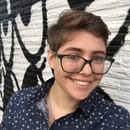“I mean, we’re pretty lucky.”
I was eighteen. It was three months until my high school graduation, and I was doing my best to convince myself and everyone around me that I was absolutely 100% straight. “We get pretty good sex-ed here—you know, we learn about more than condoms, and it’s definitely not abstinence-only.”
My friend Blu looked up at me, raising an eyebrow. “Maybe for you,” he said slowly. “But we don’t learn anything about protection for people who aren’t straight.”
My ears began to burn. “That’s….” I started, then trailed off. “Damn. That’s a good point.”
In a country where abstinence-only sexual education constitutes 23% of sexual education in public high schools, it can be difficult to see the downsides to sexual education that is inclusive of multiple birth control options, and that may even discuss the emotional aspects of sex as well. But the fact still stands that, according to a 2015 survey, as few as 12% of U.S. high schools offer sexual education that is inclusive of LGBTQ+ teens as well as straight ones. Preventing pregnancies between straight, cisgender teens is important, of course, and sexual education in the U.S. does need to improve as a whole—but while straight cis teens are almost always represented in the sexual education that does exist, LGBTQ+ teens rarely are.
When I came out as pansexual, three months after my high school graduation, I experienced the effects of some of this firsthand. Did I know how to prevent a sperm reaching an egg? Absolutely. Did I know different types of birth control, ranked by percentage of effectiveness? You’d better believe it. Did I know anything at all about interacting sexually with someone else who had a vagina?
Uh, rain check, please.
This is especially troubling, given that less than twenty years ago, the HIV/AIDS crisis was still ravaging the LGBTQ+ population—not only in the U.S. but around the world. This was, of course, not a disease restricted to the queer community, but with the help of Ronald Reagan and other conservative politicians, it was one that carried the stigma of being associated with the community, especially with regards to men who were gay or bisexual.
As the death toll soared, people within the queer community began to work to fix a problem no one knew much about yet—since its founding in 1983, the LGBT center in Lower Manhattan has been stepping in to help the queer community deal with this new danger. As the crisis continued, celebrities affected by HIV or AIDS began to come out of the woodwork (and in some cases, the closet) and speak out about the disease that was killing off millions of the U.S. population, bringing efforts to cure it much further into the mainstream. With effort and education, the death toll eventually dropped 30% in 2013 from where it had peaked in 2005, and millions of lives were potentially saved.
This makes it all the more dangerous, however, that education on sex in the LGBTQ+ community is at such a low now. I went to a liberal school in the middle of California, one of the bluest states in America, and I still had to look up different methods of protection for myself. We are blessed, today, with the internet to turn to for answers—but even that isn’t perfect, and for teens who have more conservative parents, don’t have personal computers, or simply aren’t out to themselves, sexual education at school needs to step up to fill the gap in their education.
Having gone to such a liberal school, and living now in New York City, I am one of the lucky ones; anything I don’t know already is easy to find. But I still shiver when I remember that day from senior year—with all the passion I’d always had for education regarding LGBTQ+ rights, I hadn’t even realized how much I did not know.
[All images by Unsplash]


